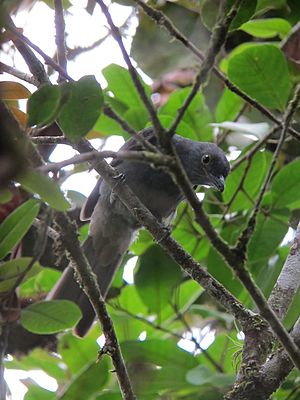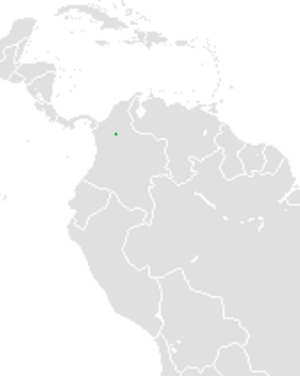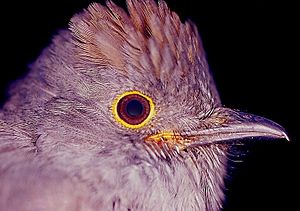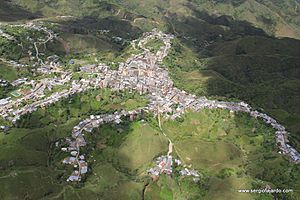Chestnut-capped piha facts for kids
Quick facts for kids Chestnut-capped piha |
|
|---|---|
 |
|
| A chestnut-capped piha in Anorí | |
| Conservation status | |
| Scientific classification | |
| Genus: |
Lipaugus
|
| Species: |
weberi
|
 |
|
| Geographic distribution shown in green | |
The chestnut-capped piha (Lipaugus weberi) is a special type of bird found only in Colombia. It lives in a small part of the Andes mountains. This bird is known for its dark grey feathers and a unique chestnut-colored cap on its head. It also has light cinnamon feathers under its tail.
Chestnut-capped pihas are fairly small, growing to about 20 to 25 centimeters (8 to 10 inches) long. Male pihas have special wing feathers that make a whirring sound. They likely use this sound to attract mates. Their calls are very loud and can be heard from over 100 meters (330 feet) away! These birds mainly eat fruit, but they also enjoy some insects. Scientists don't know much about how they raise their young.
This bird was only discovered in 1999. This was partly because its home area was hard to reach due to local conflicts. The chestnut-capped piha is now considered critically endangered. This means it is at a very high risk of disappearing forever. There might be as few as 250 of these birds left. Their biggest threat is that their forest homes are being cut down for farms and mines. Even though some areas are protected, more work is needed to save them.
Contents
Discovering the Chestnut-capped Piha
For many years, parts of Colombia's central mountains were not explored by bird scientists. This was because of local conflicts that made the area unsafe. In the 1990s, the area became safer to visit.
On March 31, 1999, a group of scientists found the first known chestnut-capped piha. They were studying birds in the La Forsoza region. They caught, photographed, and then released the bird. Later, they caught a second one. One of the scientists, Andrés M. Cuervo, thought these birds might be a new species.
In August 1999, more surveys found many of these unknown pihas. In some places, they were quite common. Two birds caught during this survey helped scientists officially describe the species in 2001. This discovery made people hope that more new species might be found in this part of Colombia.
Names for the Piha
The chestnut-capped piha is also called the chestnut-capped cotinga or Antioquia piha. Local people call it Arrierito Antioqueño. This means "little herdsman of Antioquia." They say its call sounds like the whistles used by horsemen.
The scientific name Lipaugus comes from a Greek word meaning "dark." The name weberi honors Walter H. Weber. He was a Colombian bird expert who worked to protect birds in Antioquia. The chestnut-capped piha does not have different types or subspecies. It is most closely related to the dusky piha.
What the Piha Looks Like
The chestnut-capped piha is mostly dark grey. It has a clear chestnut-colored cap on the back of its head. The feathers under its tail are a pale cinnamon color. Its upper body and wing feathers are dark grey. The edges of its feathers are lighter. As the feathers get older, they become darker and more uniform grey.
The bird's tail is dark grey-brown, long, and forked. Its legs and feet are dark grey, but the soles of its feet are yellow. The piha has dark brown eyes and a bright yellow ring around its eyes. Its beak is black, wide at the base, and has a hooked tip. Adult pihas are about 20 to 25 centimeters (8 to 10 inches) long. They weigh between 69.4 and 72.2 grams (2.4 to 2.5 ounces).
Male and female pihas look similar. However, males might be a bit bigger. Males also have special primary feathers on their wings. These feathers have stiff parts that help them make a whirring sound. Young pihas have a less obvious chestnut cap. Their wing feathers are brighter and more reddish-brown. Young males do not yet have the special wing feathers of adult males.
No other pihas live in the same area as the chestnut-capped piha. This makes it easy to tell them apart. It is different from the dusky piha because it is smaller, greyer, has a chestnut cap, and a yellow eye ring.
The Piha's Voice
Like many pihas, the chestnut-capped piha is very loud. Its call is a piercing "sreeck." The sound goes up in pitch and then quickly drops. It repeats these calls every second. When the bird is upset, it can call even faster. You can hear its call from over 100 meters (330 feet) away. The piha calls throughout the day and all year long. It also makes a quiet, nasal "gluck-gluck" sound. This is likely a call to communicate with other pihas.
Where the Piha Lives
The chestnut-capped piha lives only in the central Andes mountains of Colombia. It is found on the northern slopes of the Cordillera Central mountains. This is near the towns of Amalfi and Anorí in the department of Antioquia. Scientists know of 16 different groups of these birds in this area. Most of them are closer to Anorí. This is because more of their forest home has been destroyed near Amalfi.
This bird lives in a very specific type of forest called a cloud forest. These forests are very humid. The piha lives at elevations between 1,400 and 1,925 meters (4,600 and 6,300 feet). It might sometimes go as low as 1,200 meters (3,900 feet). The piha is most common between 1,600 and 1,750 meters (5,200 and 5,700 feet).
The cloud forest where it lives has many types of trees. The piha prefers untouched cloud forests. It may need at least 30 hectares (74 acres) of forest to live well. However, it can sometimes live in areas where some trees have been cut. The chestnut-capped piha does not migrate.
Piha Behavior and Diet
The piha usually stays in the middle or lower parts of the forest trees. It sometimes joins groups of different bird species that are looking for food. However, it only stays with them as they pass through its area. The piha tends to be slow and not very active. When it sits, it often holds its body more horizontally than other pihas. When it is upset, it flicks its tail up and raises the feathers on its head.
The chestnut-capped piha mostly eats fruit. It also eats some insects. The fruits it eats are small to medium-sized. They come from many different plant families. The piha often picks fruit while hovering in the air. Sometimes, it will eat fruit while perched on a branch. If a fruit is too big, the piha might hit it against a branch before eating it.
Scientists have not yet found a chestnut-capped piha nest. They also don't know much about its breeding behavior. It is thought to act like the dusky piha, which is a close relative. This means males might gather in special areas called "leks." There, they use their special wing feathers to make whirring noises to attract females. In March 2000, scientists saw many pihas paired up and calling often. This suggests their breeding season was about to begin. A young piha found in early June was probably only a few months old.
Protecting the Piha
The chestnut-capped piha was listed as endangered from 2002 to 2015. In 2015, it was changed to critically endangered. This is because it lives in a very small area, and its home is being destroyed. Its cloud forest home is being turned into land for farms, especially for coffee and bananas. Other areas have been affected by gold mining and soil erosion. Some of its habitat has also been replaced by other plants or by pine and cypress tree farms.
About three-quarters of its original home is believed to be gone. Nine percent of its habitat was lost between 2000 and 2010 alone. Climate change is also a threat. As temperatures rise, the piha will need to move to higher, cooler areas. But the forest might not be able to move up the mountain fast enough. When the species was first found, there were about 2,500 pihas. But in 2014, it was thought that fewer than 250 were left. In 2014, it was named Colombia's eighth most endangered bird.
Some parts of the piha's home are protected. This includes the 4.5 square kilometer (1.7 square mile) Reserva Natural La Forzosa. This is where the bird was first discovered. In 2006, the American Bird Conservancy bought the 5.3 square kilometer (2 square mile) Arrierito Antioqueño Bird Reserve. This reserve is managed by Fundación ProAves. Two smaller reserves also protect parts of its home. More work is needed to protect the piha's habitat and to learn more about its population.
Piha and Humans
The chestnut-capped piha was featured on a Colombian $1,500 postage stamp in 2008.
Images for kids
See also
 In Spanish: Arrierito antioqueño para niños
In Spanish: Arrierito antioqueño para niños








